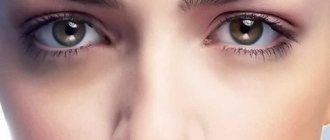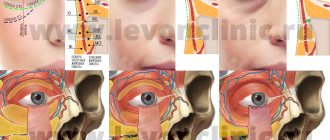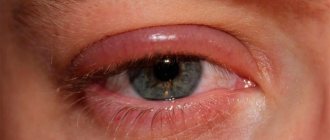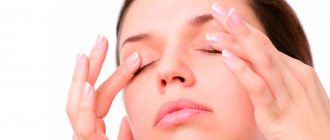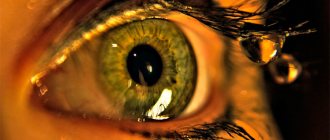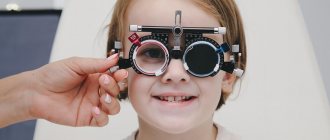Some people believe that bags under the eyes are only a cosmetic problem, but there are many reasons for swelling on the face.
To understand why bags under the eyes occur, you need to dwell a little on the anatomical features of the eye socket. The eyeball itself is a fragile organ that needs constant protection. In this regard, the eyes are surrounded on all sides by a layer of adipose tissue, which protects it and has a shock-absorbing property. This periorbital tissue is separated from the skin of the eyelids only by a thin layer of connective tissue. This membrane prevents the contents of the orbit from penetrating beyond its boundaries.
Diseases
Not always, swelling and bruising under the eyes are a sign of an unhealthy lifestyle. Often, the reason is the presence of certain diseases:
- Allergies. Accompanied by lacrimation, sneezing, redness of the eyes, difficulty breathing and coughing;
- Inflammation of the sinuses (sinusitis and sinusitis). They occur with painful sensations localized in the forehead and under the eyes, as well as copious discharge from the nose;
- Kidney diseases. When they occur, fluid retention occurs in the body, which causes not only swelling of the eyes, but also lower back pain and headaches;
- Diseases of the thyroid gland. Due to dysfunction of the thyroid gland, hormonal imbalance occurs - general weakness increases, body weight increases, the menstrual cycle changes, edema occurs;
- Heart failure. It is accompanied by shortness of breath and fatigue. Swelling and bruising under the eyes, almost invisible in the morning, appear in the late afternoon;
- Skin diseases - eczema and dermatitis.
Bags, hernias or swelling?
First, let's list all the formations that can be found in an older patient.
The formations under the eyes can be swelling, they can be sagging skin of the lower eyelid, or they can be fatty hernias.
Fig.1. 1 - swelling under the eyes; 2 - ridge of the lower eyelid during facial activity; 3 - lower eyelid hernia; 4.5 — manifestations of the nasolacrimal groove; 6 - sagging skin of the lower eyelid, facial wrinkles.
Patients often refer to swelling of the lower eyelid area as bags. Their origin has nothing to do with the redistribution of fat packets; usually it is fluid stagnation and problems with the lymphatic drainage system.
Could swelling be a symptom of an allergy?
An allergic reaction is one of the common causes of swelling. This happens because mast cells release biologically active proteins to neutralize allergens. But when combined with irritants, they cause a reaction that is similar to inflammation. Hence the swelling and redness of the eyelids. Among the ophthalmological causes of eyelid swelling, the most common are:
- glaucoma;
- conjunctivitis;
- periorbital cellulitis;
- eyelid tumors;
- injuries;
- insect bites;
- thermal, chemical burns.
Often the appearance of swelling is the body’s reaction to smoke, dust and other irritants from the external environment.
Treatment of skin allergies around the eyes
The first priority action when signs of allergy occur is to stop contact with the allergen. If symptoms appear for no apparent reason, you should change your position, take a shower, and wash your face. This increases your likelihood of reducing your exposure to the allergen, even if you don't understand what caused the symptoms.
Additionally, antihistamines must be taken, preferably second generation4. These drugs include drugs based on cetirizine, for example, Cetrin. The work of drugs in this group is to block histamine receptors, thereby relieving the clinical manifestations of allergies. The drugs begin to act in 15-20 minutes, so they quickly improve a person’s condition4.
Additional general recommendations:
- Do not rub your eyes, this aggravates the clinical manifestations.
- Use corticosteroid ointments with caution (it is advisable to consult with specialists before using this).
- Choose your antihistamine carefully.
- During treatment, avoid cosmetics, creams and any chemical products for your facial skin.
- If you are allergic to animals or pollen, do wet cleaning more often, wash clothes after returning from the street or contact with an animal.
The rate of disappearance of symptoms is influenced by: the amount and duration of exposure to the allergen, the body’s reactivity, and the use of an antihistamine.
The true causes of the formation of hernias under the eyes.
Now we’ll show you a few pictures from an anatomy textbook so that you understand the structure of this area, this is very important for determining the treatment tactics for these formations.
Pay attention to the ligaments that attach muscles and fat packets, especially how they change with age.
As we age, all our tissues wear out and stretch, including skin, muscles and ligaments.
Moreover, with age our skull changes - the eye sockets expand, and the bones of the skull seem to recede back.
Due to these changes, the deep fatty bags of the orbit, which serve as “shock absorbers” for the eyeball, begin to bulge forward, stretching the ligaments and muscles.
Fat protruding from the eye socket is the cause of bags under the eyes.
Congratulations, now you know even more than some cosmetologists who advise treating and eliminating eye bags and hernias of the lower eyelid with creams and ointments.
So, the important conclusions are:
- The classic “bag under the eye” is called a lower eyelid hernia.
- Swelling on the cheekbone under the eye is called a sac
- The nasolacrimal and midbuccal groove separates these formations.
- If the skin is stretched beyond the muscles and ligaments, then so-called “skin” bags of the lower eyelid can form.
Skin bags in the lower eyelid area are formed due to strong facial activity and stretched skin, and they can also form at a young age after losing weight.
Causes of edema formation
At a fairly young age, the formation of bags under the eyes can be caused by excessive swelling. Usually, in this case, pronounced eye bags do not appear, but the entire area under the eyes, right down to the cheekbone, can suffer from the disease.
The source of swelling under the eyes can be external influences of various factors, age, as well as diseases.
- Drinking large amounts of liquid or alcohol before bed;
- Regular lack of sleep and fatigue;
- Severe eye strain in everyday life;
- External irritating factors (contact lenses, contamination, decorative cosmetics);
- Allergic reaction (seasonal or chronic);
- Irreversible age-related changes in the body;
- Diseases of the eyes themselves (including infectious);
- Diseases of internal organs (kidneys, heart);
- Genetic predisposition.
Treatment methods
If the diagnosis does not reveal internal diseases, then circles under the eyes are a cosmetic defect that appears as a result of an incorrect lifestyle or hereditary predisposition.
In such cases, the most popular and effective treatment methods are:
- Mesotherapy. Typically, meso-cocktails are used, which contain arbutin, ascorbic, kojic and phytic acids. The therapeutic course includes 6-10 procedures, between which there is a one-week break.
- Bioreparation with ascorbic acid (vitamin C). Thanks to the combination of ascorbic and hyaluronic acid, the skin around the eyes is well moisturized and noticeably brightened. The course of treatment consists of 2-4 sessions, with a 2-week break between them.
- Plasmolifting. The procedure restores metabolism, normalizes tissue respiration, activates blood microcirculation, thereby increasing local immunity. A similar effect will appear after 4-6 sessions at weekly intervals.
- Biorevitalization. The skin around the eyes shows a pronounced reaction to dehydration and, due to dryness, often takes on an unaesthetic appearance, creating the effect of “tired eyes”. A course of birevitalization, consisting of 2-4 procedures with a 2-week interval, will help solve the problem.
- Contour plastic. If the blood vessels are located close to the skin and “see through” through it, then the filler forms an additional layer, making the vessels almost invisible. In addition, the drugs smooth out the nasolacrimal groove.
- Laser peeling. Using a laser, the top layer of skin is removed, which stimulates the regeneration process and promotes rejuvenation. The treatment course involves 2-5 procedures with a one-month break.
Why does swelling occur in dry eye syndrome?
Dry eye syndrome (DES) is a pathological condition that is based on a violation of the stability of the tear film.
It provides nutrition, hydration and protection to the cornea. But when few tears are produced or their composition changes, the tear film quickly begins to evaporate. Because of this, the mucous membrane dries out, a burning sensation, itching, redness, and swelling appears.
Various reasons contribute to the development of dry eye syndrome. This could be taking antidepressants, antihistamines, working at a computer for a long time, or staying in a room with dry air. Dry eye syndrome may progress during sun exposure (summer) because too much air temperature causes tears to evaporate.
You can compensate for moisture deficiency with the help of tear substitutes. These are special drops that contain moisturizing components. But, despite the fact that they have a composition close to tears, they do not contain mucins and lipids, which help the tear film to adhere to the surface of the eyeball and maintain stability.
One of the effective ways to restore the tear film is the use of Delfanto® in capsules. They contain a record amount of antioxidants (at least 35%), which help stimulate the production of your own tears.
What diseases can cause swollen eyes?
This symptom accompanies not only ophthalmological pathologies. It may be associated with systemic diseases. For example:
- gastrointestinal diseases;
- pathologies of the pituitary gland, thyroid gland;
- diseases of the gastrointestinal tract;
- infectious, viral diseases;
- liver and kidney diseases.
The list goes on, because there are more than 70 diseases that are accompanied by swelling of the eyelids. This could indicate problems with almost any organ.
Types of allergic reaction
Exposure to allergens can cause different types of body responses. Depending on the causes, mechanisms, and manifestations, allergies in the eye area are divided into:
- Vernal keratoconjunctivitis. A chronic seasonal disease that is typical for children and adolescents during the period of hormonal changes in the body.
- Hay fever. Seasonal response of the body to irritation by plant pollen. As a rule, it occurs annually during the flowering period of a certain plant. Any pollen can cause a problem, but most often it is ragweed and birch3.
- Chronic form. In the case of constant exposure to an allergen or a severe reaction, an immune response occurs that worries for weeks, then passes and occurs again.
- Acute reaction. Periodic allergies that occur specifically at the moment of exposure to an allergen. After it disappears, the reaction quickly passes and does not occur until contact occurs again.
Diagnosis and treatment of red spots
Most often, spots around the eyes appear suddenly - at first they may be pink, but then they actively progress and become redder. You should consult a doctor immediately if you notice pale spots - do not wait until they become pronounced.
Typically, for this symptom, doctors prescribe a general blood test, an ultrasound of internal organs, an allergic reaction test, and a skin scraping to assess the condition of the epidermis. If necessary, examinations by a dermatologist, endocrinologist, neurologist or gastroenterologist can be prescribed.
At Dr. Belikova's Eye Clinic you will receive high-quality, fast and effective medical care. We employ ophthalmologists with extensive experience in the diagnosis and treatment of diseases of the visual organs of varying degrees of complexity.
